-
Paper Information
- Paper Submission
-
Journal Information
- About This Journal
- Editorial Board
- Current Issue
- Archive
- Author Guidelines
- Contact Us
American Journal of Fluid Dynamics
p-ISSN: 2168-4707 e-ISSN: 2168-4715
2018; 8(3): 84-95
doi:10.5923/j.ajfd.20180803.02

Lattice Boltzmann Simulation of Mixed Convection Flow in a Lid-Driven Triangular Cavity Subjected to Sinusoidal Thermal Forcing Utilizing Nanofluid
Atta Sojoudi
Department of Mechanical Engineering, College of Engineering, University of Tehran, Tehran, Iran
Correspondence to: Atta Sojoudi, Department of Mechanical Engineering, College of Engineering, University of Tehran, Tehran, Iran.
| Email: |  |
Copyright © 2018 The Author(s). Published by Scientific & Academic Publishing.
This work is licensed under the Creative Commons Attribution International License (CC BY).
http://creativecommons.org/licenses/by/4.0/

Mathematical modeling was performed to simulate mixed convection of Al2O3-Water nanofluid in a lid-driven triangular cavity employing the Lattice Boltzmann Method (LBM). Two inclined cold walls are kept at constant temperatures where the bottom lid-driven wall is subjected to sinusoidal thermal boundary condition. Different thermal conductivity and viscosity of working nanofluid were considered. The study was carried out for different Richardson numbers, 0.01≤Ri≤100, Aspect Ratios, 0.2≤AR≤1, nanoparticle solid volume fractions, 1%≤φ≤5% and different frequencies and amplitudes of sinusoidal thermal forcing of lid-driven wall. Results are presented in terms of stream function and temperature contours and mean Nusselt number of all heated walls at steady state condition. To have a better insight into the fluid flow, horizontal component of fluid velocity was plotted at mid-section of the cavity for all studied cases. The grid sensitivity test was carried out and results were validated against the experimental study.
Keywords: Lattice Boltzmann Method, Mixed convection, Al2O3-Water nanofluid, Lid-driven triangular cavity
Cite this paper: Atta Sojoudi, Lattice Boltzmann Simulation of Mixed Convection Flow in a Lid-Driven Triangular Cavity Subjected to Sinusoidal Thermal Forcing Utilizing Nanofluid, American Journal of Fluid Dynamics, Vol. 8 No. 3, 2018, pp. 84-95. doi: 10.5923/j.ajfd.20180803.02.
Article Outline
1. Introduction
- Although many numerical and experimental researches have been conducted to study different aspects of engineering problems [1-7] and specifically heat transfer in fluid flow [8, 9], an analytical approach was found suitable for the current study. Fluid flow and thermal performance of lid-driven cavities have received great attention from researchers for many years due to their prime importance in lubrication technologies, electronic cooling, solar collectors, food processing and nuclear reactors [10]. Most of the working fluids employed in lid-driven cavities with horizontal [11], vertical [12] and oscillating moving walls have low thermal performance. Due to great importance of efficient cooling systems, there is a major request for better industrial design of thermal systems to maintain the temperature of heated components below the safe limits. Choi [13] observed that adding nanoparticles with higher thermal conductivity to the base fluid, results in nanofluids with better thermal performance and heat transfer characteristics. Hafezisefat et al. [14] numerically and experimentally studied the effects of nanofluid on improvement of heat transfer inside a jacket and found good agreement between both approaches. Heat transfer enhancement by adding nanoparticles into pure water for lid-driven cavities has been confirmed through recent studies [15]. Moreover, aspect ratios of cavity, solid volume fraction and direction of moving wall have considerable effects on fluid flow and thermal performance of the enclosure. However, it should be noted that the issue of adding nanoparticles to the base fluid still remains a controversial subject, which states that the dispersion of nanoparticles in the initial base fluid may result in a less efficient thermal performance and lower thermal conductivity of the solution than expected [16, 17]. Predication of the thermal performance of nanofluids in numerical studies depends on the employed mathematical models [18, 19]. Considering limitations in the prediction of thermal performance of nanofluids using numerical approaches, these techniques are still very helpful to study this subject [20-22] and have shown good results in academic and engineering case studies. Plenty of studies have considered natural convection in triangular enclosures; however, few studies are related to fluid flow and heat transfer phenomenon in triangular cavity filled with nanofluid. Ghasemi and Aminossadati [23] numerically considered the effects of Brownian motion of nanoparticles on the natural convection of a water–CuO nanofluid in a right triangular cavity with stationary walls. They reported that it was required to consider the Brownian motion of nanoparticles in the thermal performance analysis of nanofluid-filled enclosures. They also [24] studied mixed convection of water-Al2O3 nanofluid in a lid-driven right triangular cavity and reported the enhancement of heat transfer rate after adding Al2O3 nanoparticles. In their other study on natural convection of Ethylene Glycol-copper nanofluid in an isosceles triangular enclosure with heat source located at its bottom wall [25], they found that the thermal performance of the cavity was improved with an increase in the Rayleigh number and solid volume fraction.Commercial CFD codes are appropriate for numerical modeling of fluids; however, finite element method, using multiphysics software which offer a variety of user friendly subroutines [26, 27] can also be used to study this phenomena. Ching et al. [28] used finite element technique to simulate mixed convection heat and mass transfer in a right triangular enclosure. They showed that the increase of buoyancy ratio enhances the heat and mass transfer rate for all values of Richardson number and for all directions of the sliding wall motion. However, the direction of the sliding wall motion can be an appropriate control parameter for the flow and temperature fields. Rahman et al. [29] considered unsteady natural convection of water-Al2O3 nanofluid in a triangular enclosure where the bottom of the isosceles triangular cavity is heated non-uniformly and temperature of the inclined wall is lower than that of the bottom wall. They concluded that heat transfer increases with addition of nanoparticle and increase in Rayleigh number.To the best of the knowledge of the authors, very limited studies are related to the natural convection of nanofluid in a triangular enclosure subjected to the sinusoidal thermal forcing. In the present study, thermal performance of a lid-driven triangular enclosure filled with water-Al2O3 nanofluid where the bottom driven wall is subjected to the sinusoidal thermal forcing is determined.
2. Mathematical Model and Simulation Methodology
2.1. Physical Properties of Nanofluid
- Density of the water-Al2O3 nanofluid is calculated through the classical formula developed for conventional solid-liquid mixtures:
 | (1) |
 | (2) |
 | (3) |
 | (4) |
 | (5) |
 | (6) |
 | (7) |
 | (8) |
|
2.2. Governing Equations
- Natural convection heat transfer of water-Al2O3 nanofluid in a two dimensional lid-driven triangular cavity is considered (Fig. 1). H and L are height and length of the base of the triangle, respectively. Inclined cold walls are kept at Tc while the bottom driven wall is sinusoidally heated. A is thermal forcing amplitude where 0.5n shows its frequency. For n=2, there is a complete cycle of thermal heating, in other words, half of the base is heated to Th and the other half is cooled to Tc. For Steady state condition, laminar, incompressible and homogeneous Newtonian fluid is assumed for the present study. Governing equations for continuity, momentum and fluid energy are defined as follow:
 | (9) |
 | (10) |
 | (11) |
 | (12) |
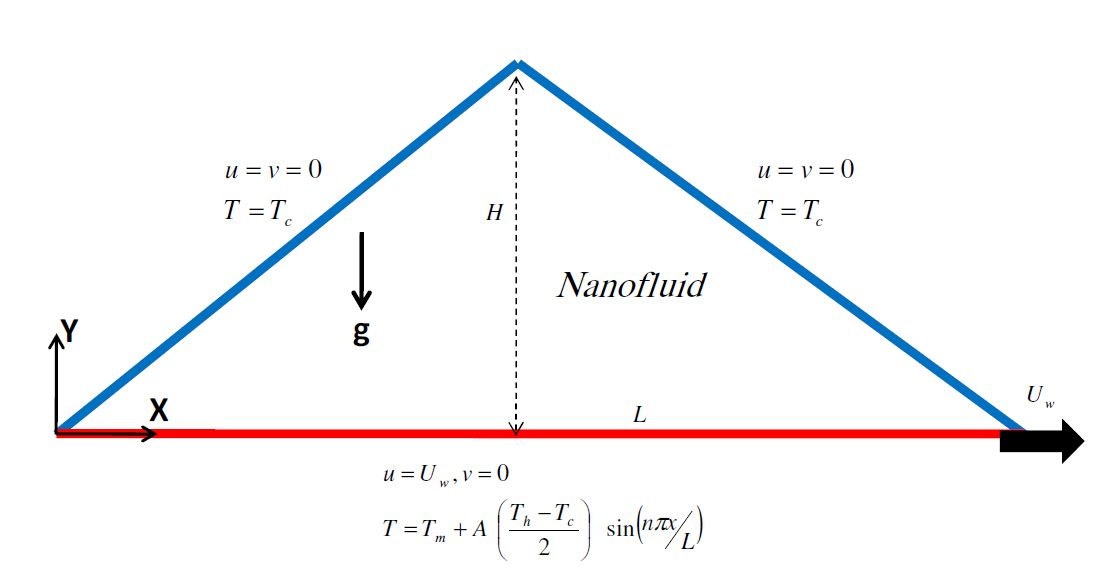 | Figure 1. A schematic diagram of the physical model |
 | (13) |
 | (14) |
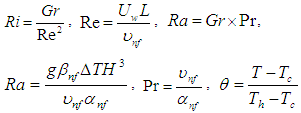 Two important parameters of local Nu and mean Nu are defined below, and are widely investigated.
Two important parameters of local Nu and mean Nu are defined below, and are widely investigated.

 l is parallel to the wall
l is parallel to the wall2.3. Lattice Boltzmann Method
- Since the Lattice Boltzmann Method (LBM) is much more computationally efficient than classical CFD [34-38] or image processing techniques [39-41], it was used to determine the desired flow field and heat transfer phenomenon; where it adopts a uniform lattice with BGK collision model. Thermal lattice Boltzmann equations [42] are remarked as follow:
 | (15) |
 | (16) |
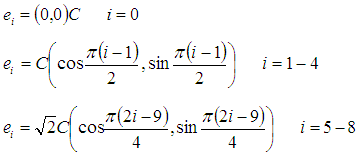 | (17) |
 | (18) |
 | (19) |
 | (20) |
 | (21) |
 | (22) |
 | (23) |
 | (24) |
 | (25) |
 | (26) |
 | (27) |
2.4. Convergence Criterion
- A uniform grid was used for all simulations where the convergence criteria is defined as:
 | (27) |
 | (28) |
3. Results and Discussion
- In the current study, it was assumed that Ra=105. The Richardson number (Ri), and solid volume fraction (ϕ) were considered to be in the range of 0.01≤Ri≤100 and 0≤ϕ≤0.05, respectively. The analysis was performed for pure water (ϕ=0), as well as for a water-based nanofluid with 38 nm diameter Al2O3 nanoparticles.
3.1. Simulation Validation
- Numerical simulations were performed using different mesh sizes ranging from 10000 up to 17000. A FORTRAN code is developed to solve the present problem using a structured mesh of square type. The details of this method are mentioned in references [42, 43]. It was concluded that the optimal computational mesh that contributed grid independent solutions comprised of 15600 elements. Symmetrical lattices with respect to the midplane of the triangular enclosure were distributed. For validation of numerical results, static and adiabatic thermal boundary conditions for bottom wall, and differential heating for the right and left walls were assumed. Considering a triangular enclosure of AR=1 with Gr=2.1577×107 and Pr = 0.71, numerical results of local Nu for cold inclined wall were compared with Flack et al. [44]. Fig. 2 shows a satisfactory agreement between present results and the previous results from the experimental study of Flack et al [44].
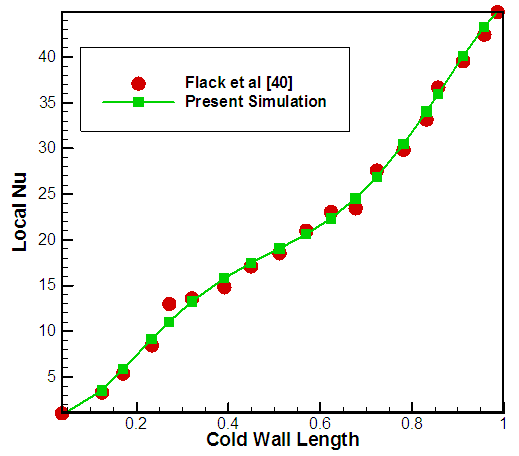 | Figure 2. Comparison of local Nu for cold inclined wall with Flack et al [40] |
3.2. Effect of Ri
- In this section, effect of Ri on flow field and heat transfer phenomenon is studied. Fig. 3 illustrates contours of temperature and stream function for water-Al2O3 nanofluid with 2% solid particle volume fraction, AR=0.5, A=1 and n=2. A large cell is formed near the right corner, due to the movement of bottom wall for Ri= 0.01. With increase in Ri to 0.1, single cell is shifted toward the center of the cavity, later divided into two cells near the bottom wall due to the strengthening buoyant flow. It is evident that maximum stream function value is reduced with the increase of Ri. For higher value of Ri, Ri=10 and 100, one large cell is formed at the core of the enclosure approximately occupying the entire domain and gets lager with increase in Ri, while a little cell that is created at the right corner of the cavity gets smaller due to the development of large central cell. From the temperature contours, it is evident that for lower Ri, due to dominant forced convection heat transfer, core and upper part of cavity are influenced by high temperature of half bottom wall. With increase in Ri, natural convection heat transfer is dominant and nearly left half of the enclosure is effected by left bottom hot part, and right half of the cavity is influenced by right cold bottom part.
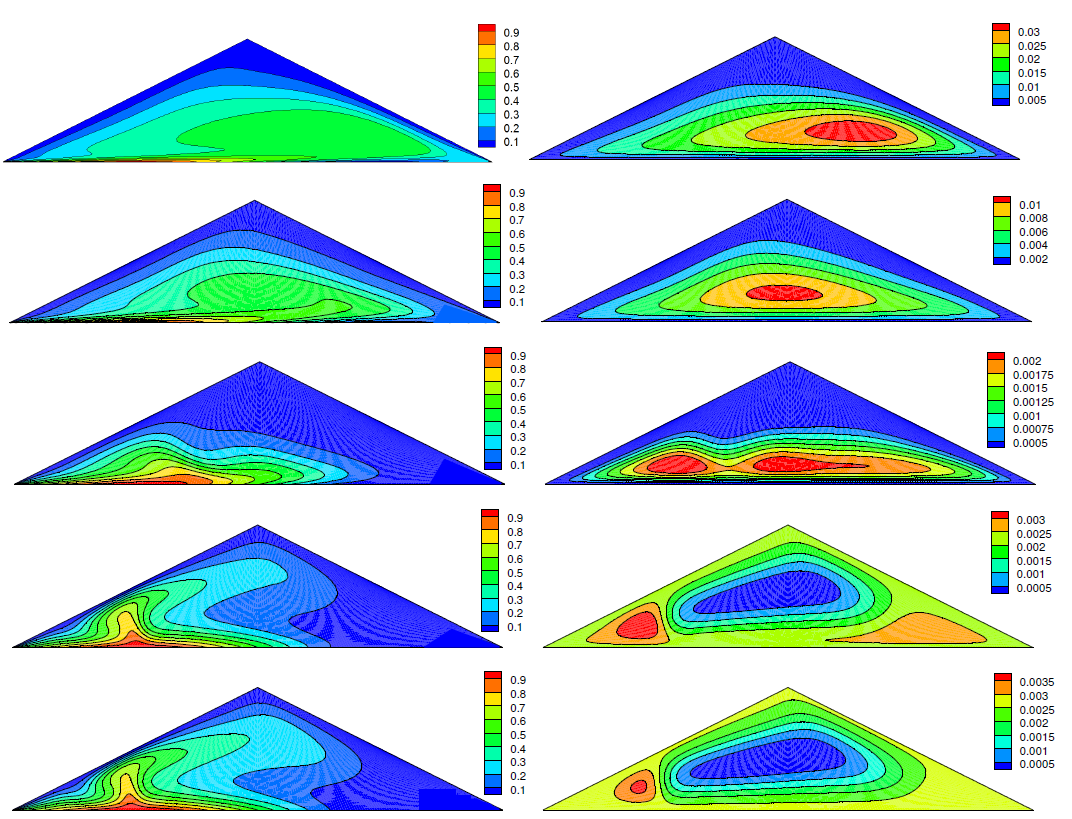 | Figure 3. Dimensionless temperature (Left) and stream function (Right, Kg/s) contours of water-Al2O3 nanofluid with φ=2%, AR=0.5, A=1 and n=2 |
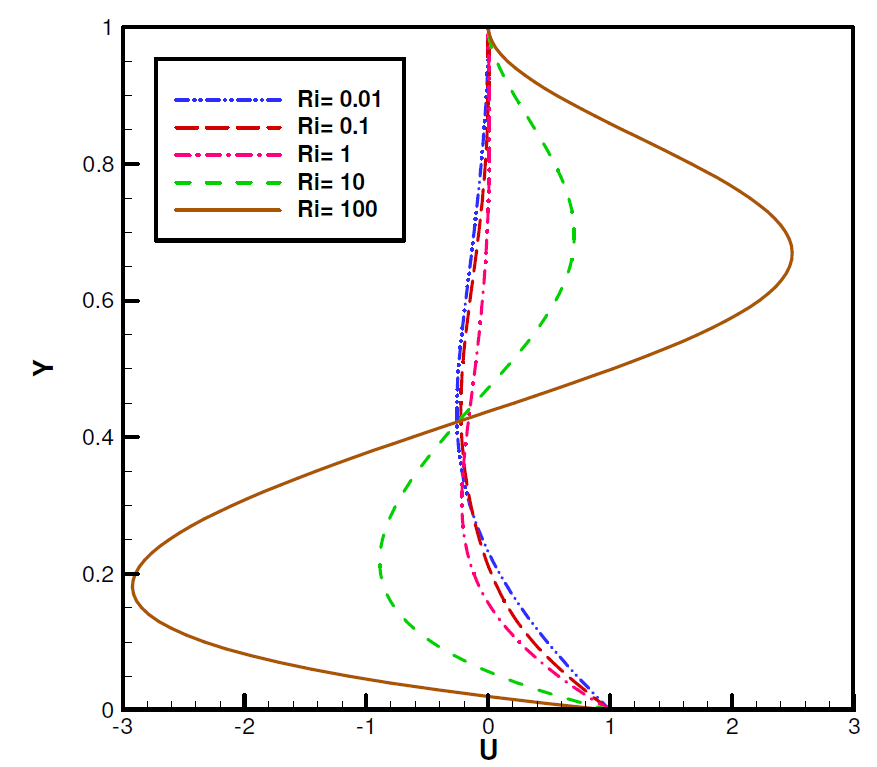 | Figure 4. Profiles of x-velocity (U) at the midsection of the cavity for =2%, AR=0.5, A=1 and n=2 |
 | Figure 5. Mean Nu variation of three walls in terms of Ri for =2%, AR=0.5, A=1 and n=2 |
3.3. Effect of AR
- Fig. 6 shows the effect of different AR on distribution of temperature and stream function for φ=2%, Ri=1, A=1 and n=2. For AR=0.2, due to the lower distance of the left cold inclined wall and the left hot portion of the bottom wall, conduction heat transfer is dominant for the left corner, while the natural convection heat transfer is dominant for middle part of the cavity. Three cells are formed within the cavity. With increase in AR, number of cells are reduced and forced convection heat transfer is reinforced, so more than half of the enclosure is affected by the bottom high temperature. There is only one cell at the core of enclosure for AR=1. U velocity profiles at the midsection for three different ARs are plotted in Fig. 7 for Ri=1. It is seen that absolute magnitude of horizontal velocity is higher for lower AR due to the dominant natural convection heat transfer for the middle part of the cavity. Fig. 8 represents mean Nu of three walls of the cavity for various AR, φ=2%, Ri=0.01 and 100, A=1 and n=2. It is seen that with increase in AR, mean Nu of the bottom wall is reduced, which is related to reduction of shear stress according to Fig. 7. Absolute value of mean Nu for inclined walls are also reduced with increase of AR. It is due to the reduction of heat flux into the system from the bottom wall.
 | Figure 6. Dimensionless temperature (Left) and stream function (Right, Kg/s) contours for various AR when φ =2%, Ri=1, A=1 and n=2 |
 | Figure 7. Profiles of x-velocity (U) at the midsection of the cavity for different AR and φ =2%, Ri=1, A=1 and n=2 |
 | Figure 8. Mean Nu variation of three walls in terms of AR for φ =2%, Ri=0.01 and 100, A=1 and n=2 |
3.4. Effect of Nanofluid Volume Fraction
- In Fig. 9, contours of temperature and stream function for various solid volume fractions of water-Al2O3 nanofluid are plotted while AR=0.5, Ri=1, A=1 and n=2. It is evident that for φ=1%, two rotating cells are formed near the bottom wall. With increase in solid volume fraction, natural convection heat transfer becomes dominant where 3 rotating cells are formed for φ=5%, and maximum stream function is enhanced up to higher solid volume fraction. U velocity profiles of different solid volume fractions are plotted in Fig. 10. There is a similar flow pattern and approximately equal U magnitude for all solid volume fractions at the same Ri, and the existing difference of the magnitude of U when φ=3% at Ri=100 may be related to the displacement of the cells that are formed near the bottom wall. Fig. 11 displays mean Nu of walls in terms of solid volume fractions. The absolute heat transfer rate increases as the solid volume fraction increases. This is due to the increase in the volume of solid nanoparticles with relatively higher thermal conductivity. It is also noteworthy that the right cold inclined wall is associated with higher absolute mean Nu for lower Ri, while the left cold wall has higher absolute mean Nu for higher values of Ri (natural convection is dominant).
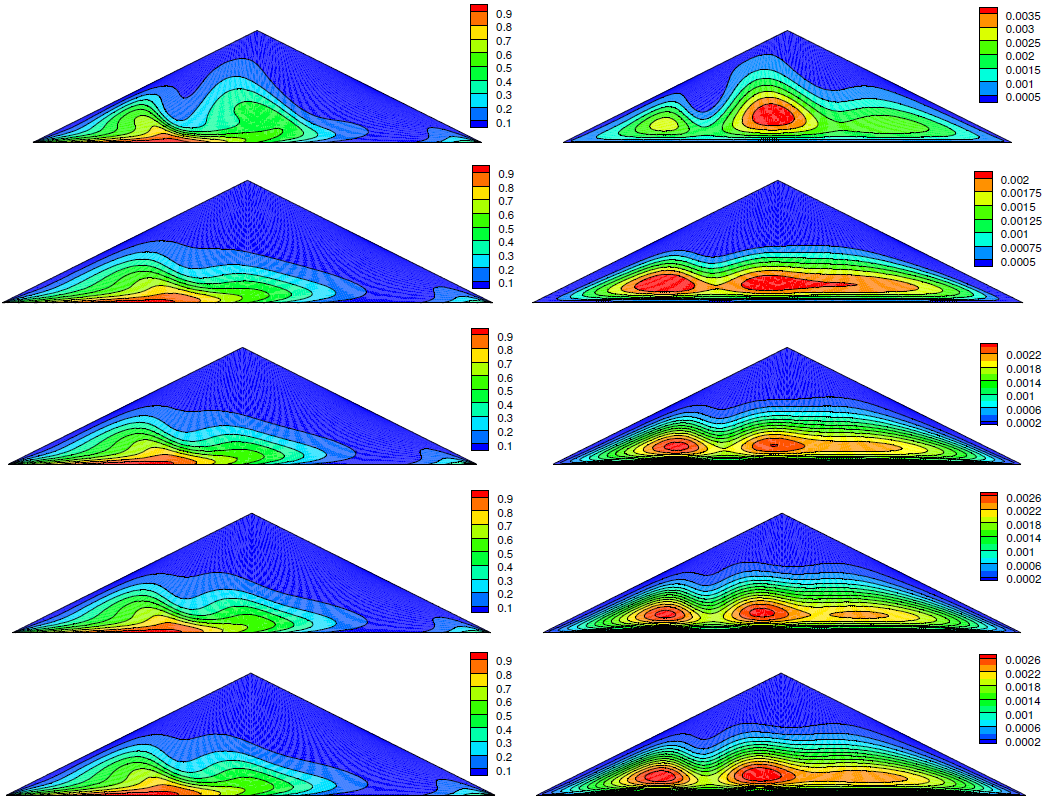 | Figure 9. Dimensionless temperature (Left) and stream function (Right, Kg/s) contours for various solid volume fractions of water-Al2O3 when AR=0.5, Ri=1, A=1 and n=2 |
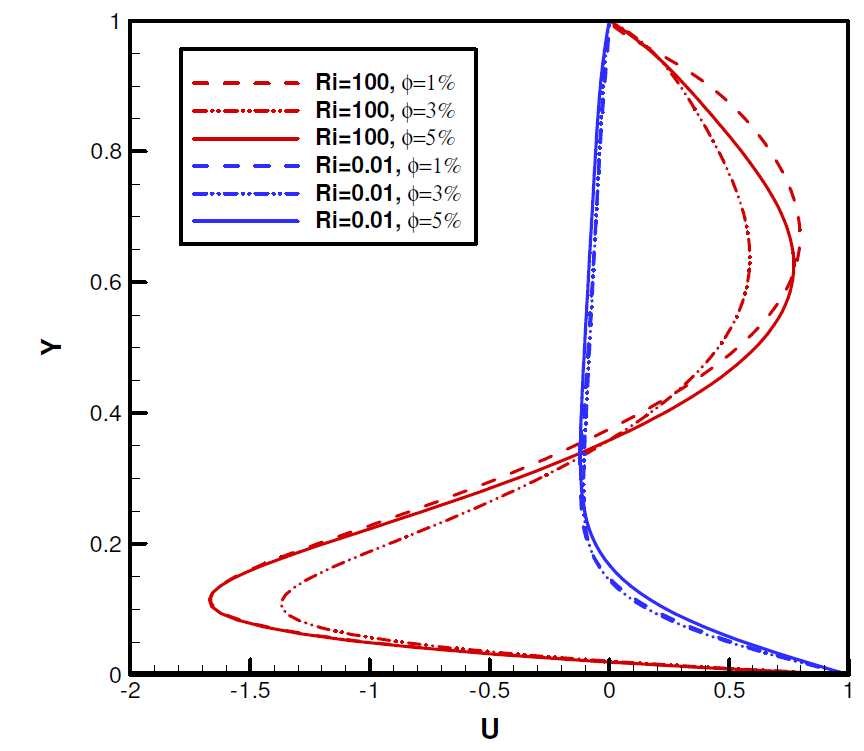 | Figure 10. Profiles of x-velocity (U) at the midsection of the cavity for different solid volume fractions and AR=0.5, Ri=0.01 and 100, A=1 and n=2 |
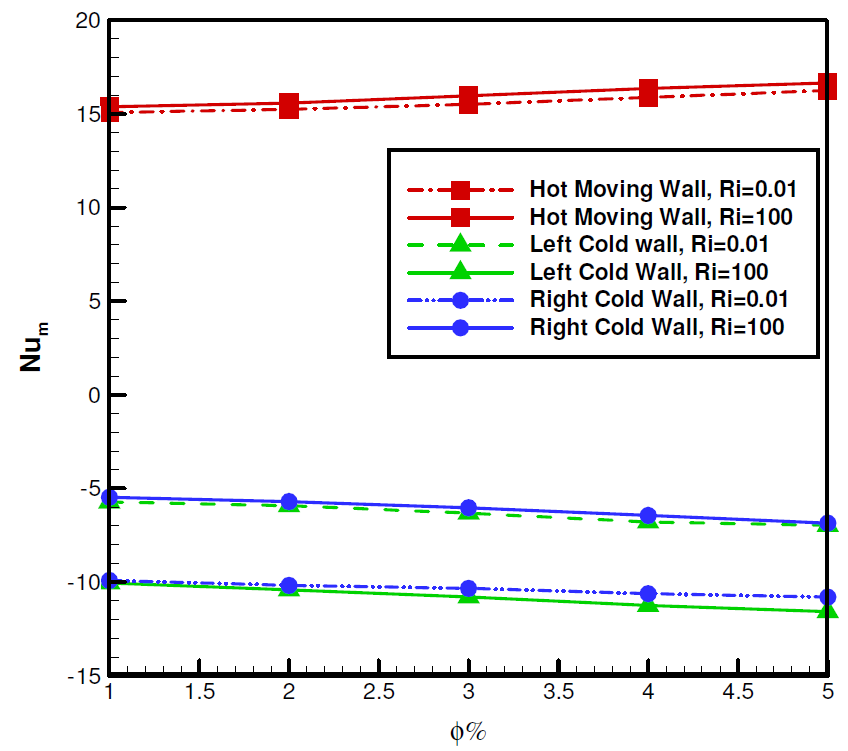 | Figure 11. Mean Nu variation of three walls in terms of solid volume fractions for AR=0.5, Ri=0.01 and 100, A=1 and n=2 |
3.5. Effect of Frequency and Amplitude of Thermal Forcing
- In this section, effects of frequency and amplitude of sinusoidal thermal forcing on flow field and heat transfer is discussed. Fig. 12-a displays contours of temperature and stream function for various thermal forcing frequency when AR=0.5, φ =2%, Ri=1, A=1. Maximum value of stream function is increased with the enhancement of the frequency. Moreover, cellular flow pattern is seen where 2 rotating cells are formed near the bottom wall and a single cell is created near the top. Much of the area of the enclosure is affected by the hot temperature of the bottom wall for higher frequencies. In Fig. 12-b, it is illustrated that for A=0.5, stratified temperature contour occupies the locations adjacent to the bottom wall and with increase in amplitude more cells are formed within the cavity. Parallel stream lines form adjacent to the inclined walls for A=1.5, which are associated with strong conduction heat transfer mechanism.
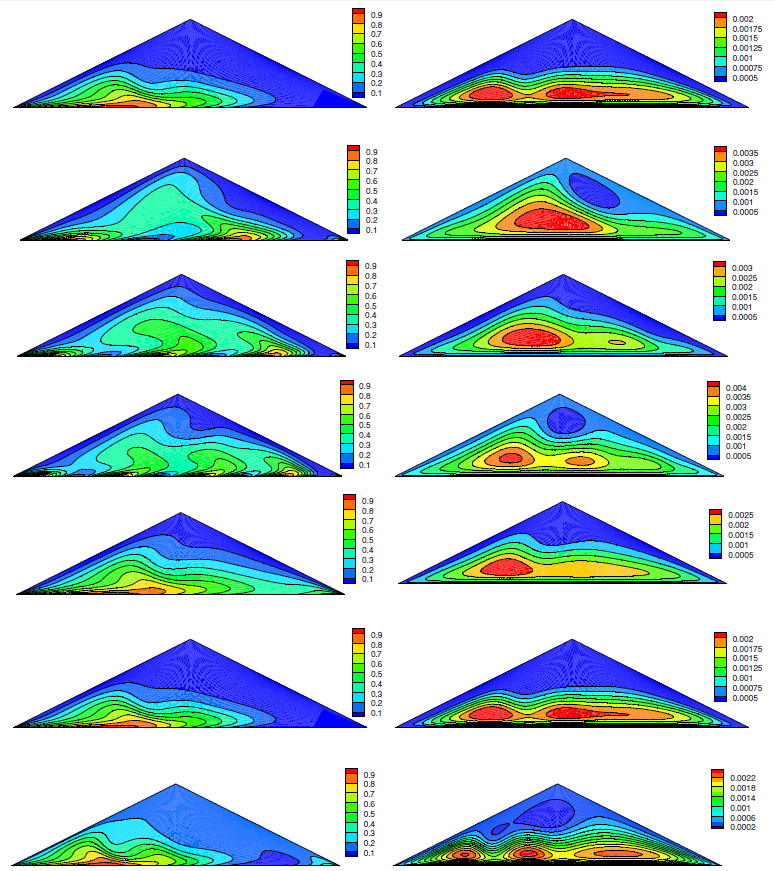 | Figure 12. Dimensionless temperature (Left) and stream function (Right, Kg/s) contours for a) Frequency (1 to 4) b) Amplitude (0.5 to 1.5) of water-Al2O3 when AR=0.5, φ=2% and Ri=1 |
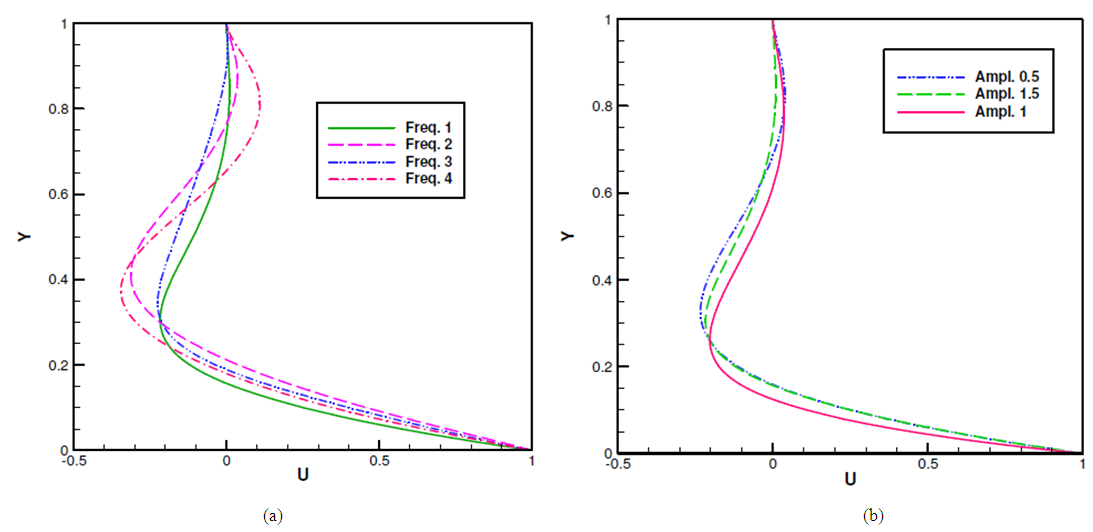 | Figure 13. Profiles of x-velocity (U) at the midsection of the cavity for a) Frequencies b) Amplitudes and φ =2%, AR=0.5, Ri=0.01 and 100 |
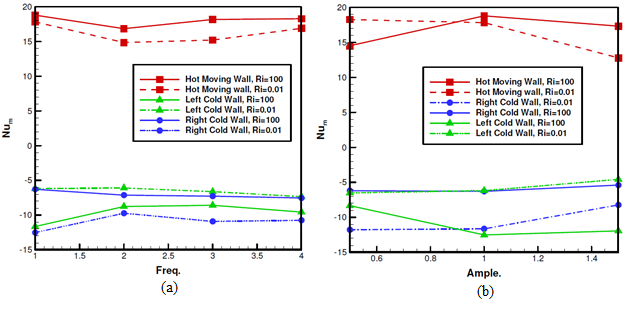 | Figure 14. Mean Nu variation of three walls in terms of a) Frequency b) Amplitude for AR=0.5, Ri=0.01 and 100 |
4. Conclusions
- The natural convective flow and heat transfer features of a lid-driven triangular enclosure with 38nm Al2O3/water nanofluids are numerically tested using the lattice Boltzmann method (LBM). Incline boundaries of the cavity are cooled to a constant temperature while the bottom driven wall is subjected to a sinusoidal thermal forcing. Using variable viscosity and thermal conductivity models, the analysis was performed for different Richardson numbers, 0.01≤Ri≤100, Aspect Ratios, 0.2≤AR≤1, nanoparticle solid volume fractions, 1%≤φ≤5% and different frequencies and amplitudes of sinusoidal thermal forcing of lid-driven wall. Some important outcomes are as follow:• The absolute magnitude of U increases as Ri increases.• For the moving wall, mean Nu decreases with increase in Ri up to Ri=1, due to the descending magnitude of force convection heat transfer, then it rises up on behalf of reinforced natural convection effect.• With increase in AR, number of cells are reduced and forced convection heat transfer is reinforced.• With increase in AR, mean Nu of the bottom wall is reduced; this is related to the reduction of shear stress near the moving wall.• Addition of nanoparticles showed to improve the heat transfer rate in the cavity.• Variation of frequencies and amplitudes of sinusoidal thermal forcing affects the flow and temperature distribution within the enclosure.
 Abstract
Abstract Reference
Reference Full-Text PDF
Full-Text PDF Full-text HTML
Full-text HTML